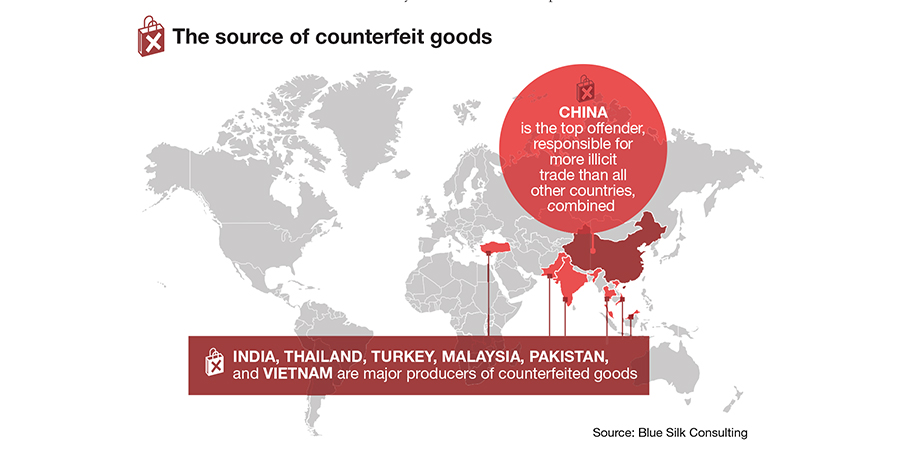Are there counterfeits in your global supply chain?
Determining if there are counterfeit products in your supply chain is no easy task. How do you know if you’re buying and using true products from your suppliers and distribution channels?
The problem of counterfeiting is a multi-headed monster—and it’s growing. According to the European Organization for Economic Cooperation and Development (OECD), the risk of a consumer purchasing counterfeit goods in the United States or the EU is roughly one in 20—and it gets bigger each year. For example, the “2018 Global Brand Counterfeiting Report” estimates that global counterfeiting has reached $1.2 trillion. OECD projects that about $2 trillion worth of counterfeit goods will be sold worldwide in 2020. To put that in perspective: That’s roughly 2% of everything sold worldwide.
In the United States and EU, roughly 5% to 6% of imports are believed to be fakes. It’s estimated that the U.S. Customs and Border Patrol (CBP) only captures 1% of fakes imported (e.g., 34,143 seizures of valued at approximately $1.2 billion in 2017).
When counterfeit goods are unknowingly added to supply chains, parts, sub-assemblies and products can be compromised and consumers can be endangered. The aerospace and defense industries are concerned about counterfeit parts, but so are pharmaceutical and beauty industry companies along with big brand name consumer products. No one wants to think there are counterfeit parts in the airplane when you board a commercial aircraft, or drive a new car, or take a supplement.
Is it the real thing?
It has become increasingly more difficult to distinguish a counterfeit from the real thing. Owners of brands and intellectual property are losing billions of dollars in revenue every year to counterfeiters that are selling bogus products, often at the same price as the true brand.
Using the latest manufacturing and printing technologies, counterfeiters are able to duplicate finishes, stenciling, print boxes, labels and security codes that mimic those on the genuine products. Many fakes are undetectable to the average consumer.
Even professional industrial buyers often have a difficult time in distinguishing genuine products. Tasked with getting the best price and delivery, buyers may be duped into buying counterfeits because they’re marginally less expensive.
In addition, most purchasing departments have added new tools such as Amazon Marketplace and Alibaba, where buyers are presented with the lowest price. However, Amazon and Alibaba are notorious for hosting counterfeiters and only address the issue when they receive brand inquiries and complaints, but both companies have made some progress in using Artificial Intelligence and Big Data to identify counterfeiters.
Where do counterfeits come from?
Where do these counterfeit parts come from? China is the largest source of counterfeit items—about 80% of imported counterfeits come from China. Eastern Europe, South America and the Middle East are also known sources of counterfeits. (See Figure below)

Because of the current global trade wars and shifting production to other countries, counterfeiters are also on the move. Counterfeits from Vietnam and India in particular have increased in the past year. And, as supply chains move out of China, so do the counterfeiters.
Importing counterfeit products
CBP selects only 3% to 5% of cargo shipments coming into the U.S. for physical examination where a counterfeit product might be caught. Cargo is selected for examination based on a risk algorithm or a statistical random sample. As a result, many shipments simply pass through the import process with an electronic document filing, and are delivered directly to an e-commerce fulfilment warehouse or to an end-user.
Once in an e-commerce fulfilment warehouse, the products are sold via e-commerce websites such as eBay and Amazon, without the importer ever checking the physical item. eBay and Amazon Marketplace orders are fulfilled through these third party warehouses and shipped directly to the consumer. Although most on-line retailers have strict written policies about counterfeiting, they’re very difficult to enforce, while counterfeits are difficult to identify until there is a quality issue or complaint.
Brick and mortar retailers may unknowingly sell counterfeits as they are sometimes mixed in with the true brands. The counterfeits have gotten so close that they’re practically indistinguishable with the true brands, tags and gift boxes. These counterfeits are often sold at a slightly reduced price, so the product looks similar to the true product, but seems to be a bargain.
For example, a high-end name brand silk scarf might cost $300 at retail, but the counterfeit with a different color or different pattern marked with the same brand name is sold for $200 or $250. Or perhaps the counterfeit scarf is sold on eBay as “previously owned” for as little as $100. Even the boxes they come in look legitimate. The true brand loses millions in revenue because of these counterfeit goods and tactics.
What is the risk? Strict liability without intent
If you transport, warehouse or fulfill counterfeits, your services fall under the Lanham Act, 15 U.S.C. § 1051 et seq. In tort law, strict liability is the imposition of liability on a party without a finding of intent. This means that even if your company had no idea that it was transporting, warehousing, or fulfilling orders with counterfeit goods, you can be found guilty of violating the Landham Act and lose a lawsuit with fines and penalties. On-line warehouse/fulfillment operators, retailers and other supply chain links could easily go bankrupt trying to fight a legal battle if they’re caught dealing with counterfeits.
Generic products versus counterfeit products are another reason for supply chain professionals to pause. Generics are less expensive and seem to operate the same as branded products, but without the brand warranty. In fact, generic products are often manufactured on the same production lines as the true branded product. But buyer beware: generics are often made from sub-standard component parts. Counterfeit goods are copies (often less expensive imitations) that represent themselves as the true branded products.
Of course, knowingly importing counterfeits, is a federal criminal offense punishable by millions of dollars in fines plus significant jail time.
For manufacturing supply chains, the risk is in procuring counterfeit parts that don’t preform as expected or cause other parts to fail for unknown reasons. This can result in delayed production, product failure or even potential harm to an end-user.
How to control counterfeits in your supply chain
The only way to control counterfeiting is to maintain tight control over your entire worldwide supply chain and enforce discipline in verifying supply chain partners and products.
This means verifying and monitoring all parts suppliers, distributors, subcontractors and contract manufacturers. It simply isn’t good enough to show up at a supplier location once a year and hope for the best. Companies sourcing in China and other countries should go often and review the production of their own parts. There is no substitute for attention to detail in every supply chain link.
Product testing and quality reviews are other ways of detecting counterfeits. But even these processes can overlook counterfeit parts that are nearly undetectable until the item fails or causes harm.
Make sure all supply chain links are verified and overseen regularly—take nothing for granted. Know your supply chains from start to finish and verify and monitor every step.
Finding and fighting counterfeiters is hard work and may be a relentless task. But protecting brands and trademarks—and ultimately a company’s revenue and reputation—is critical to maintaining brand value

Article Topics
Global Trade News & Resources
Supply Chain Stability Index sees ‘Tremendous Improvement’ in 2023 Descartes March Global Shipping Report highlights ongoing steady volume momentum U.S.-bound import growth track remains promising, notes Port Tracker report EU Update 2024: Crises lead to growth Examining the impact of the Taiwan earthquake on global supply chain operations Descartes announces acquisition of OCR Services Inc. Industry experts examine the impact of Baltimore bridge collapse on supply chains More Global TradeLatest in Logistics
LM Podcast Series: Assessing the freight transportation and logistics markets with Tom Nightingale, AFS Logistics Investor expectations continue to influence supply chain decision-making The Next Big Steps in Supply Chain Digitalization Warehouse/DC Automation & Technology: Time to gain a competitive advantage The Ultimate WMS Checklist: Find the Perfect Fit Under-21 driver pilot program a bust with fleets as FMCSA seeks changes Diesel back over $4 a gallon; Mideast tensions, other worries cited More LogisticsSubscribe to Logistics Management Magazine

Find out what the world's most innovative companies are doing to improve productivity in their plants and distribution centers.
Start your FREE subscription today.
April 2023 Logistics Management

Latest Resources
















